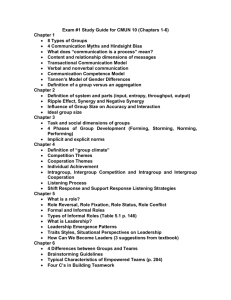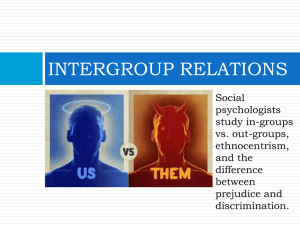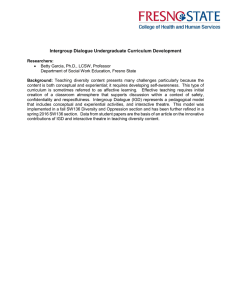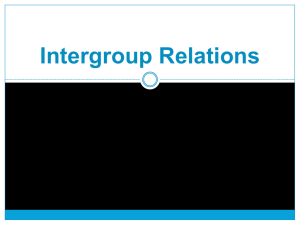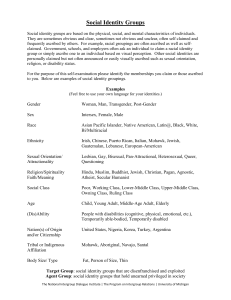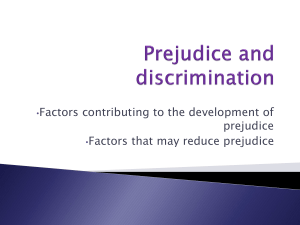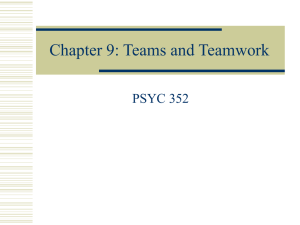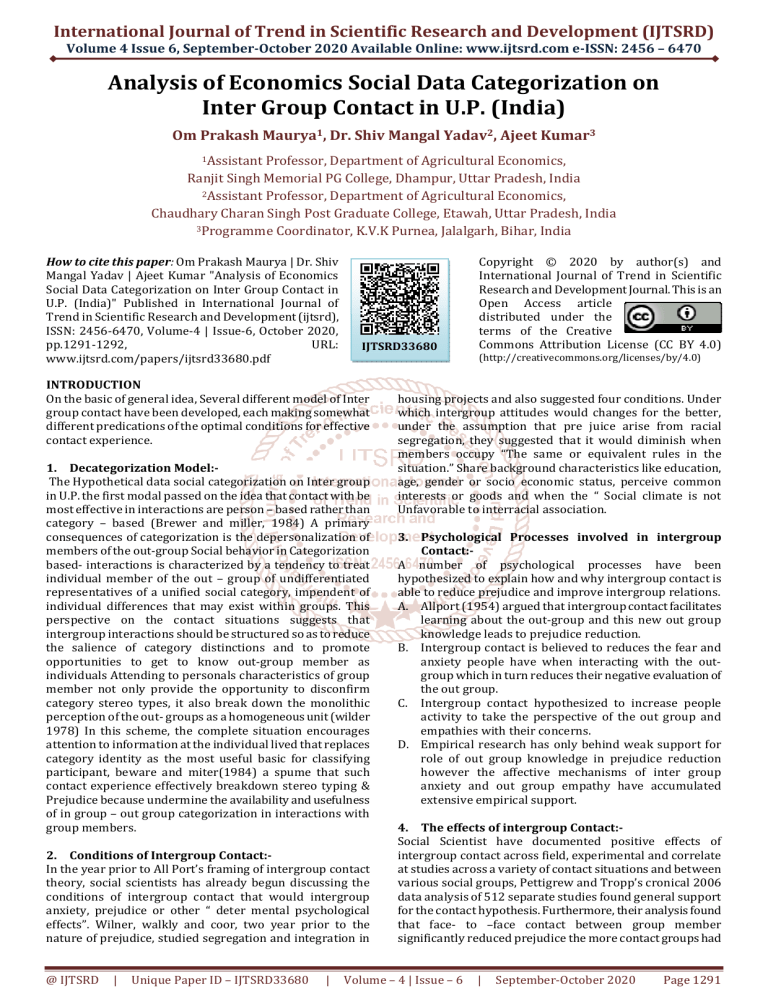
International Journal of Trend in Scientific Research and Development (IJTSRD)
Volume 4 Issue 6, September-October 2020 Available Online: www.ijtsrd.com e-ISSN: 2456 – 6470
Analysis of Economics Social Data Categorization on
Inter Group Contact in U.P. (India)
Om Prakash Maurya1, Dr. Shiv Mangal Yadav2, Ajeet Kumar3
1Assistant
Professor, Department of Agricultural Economics,
Ranjit Singh Memorial PG College, Dhampur, Uttar Pradesh, India
2Assistant Professor, Department of Agricultural Economics,
Chaudhary Charan Singh Post Graduate College, Etawah, Uttar Pradesh, India
3Programme Coordinator, K.V.K Purnea, Jalalgarh, Bihar, India
How to cite this paper: Om Prakash Maurya | Dr. Shiv
Mangal Yadav | Ajeet Kumar "Analysis of Economics
Social Data Categorization on Inter Group Contact in
U.P. (India)" Published in International Journal of
Trend in Scientific Research and Development (ijtsrd),
ISSN: 2456-6470, Volume-4 | Issue-6, October 2020,
pp.1291-1292,
URL:
www.ijtsrd.com/papers/ijtsrd33680.pdf
IJTSRD33680
(http://creativecommons.org/licenses/by/4.0)
INTRODUCTION
On the basic of general idea, Several different model of Inter
group contact have been developed, each making somewhat
different predications of the optimal conditions for effective
contact experience.
1. Decategorization Model:The Hypothetical data social categorization on Inter group
in U.P. the first modal passed on the idea that contact with be
most effective in interactions are person – based rather than
category – based (Brewer and miller, 1984) A primary
consequences of categorization is the depersonalization of
members of the out-group Social behavior in Categorization
based- interactions is characterized by a tendency to treat
individual member of the out – group of undifferentiated
representatives of a unified social category, impendent of
individual differences that may exist within groups. This
perspective on the contact situations suggests that
intergroup interactions should be structured so as to reduce
the salience of category distinctions and to promote
opportunities to get to know out-group member as
individuals Attending to personals characteristics of group
member not only provide the opportunity to disconfirm
category stereo types, it also break down the monolithic
perception of the out- groups as a homogeneous unit (wilder
1978) In this scheme, the complete situation encourages
attention to information at the individual lived that replaces
category identity as the most useful basic for classifying
participant, beware and miter(1984) a spume that such
contact experience effectively breakdown stereo typing &
Prejudice because undermine the availability and usefulness
of in group – out group categorization in interactions with
group members.
2. Conditions of Intergroup Contact:In the year prior to All Port’s framing of intergroup contact
theory, social scientists has already begun discussing the
conditions of intergroup contact that would intergroup
anxiety, prejudice or other “ deter mental psychological
effects”. Wilner, walkly and coor, two year prior to the
nature of prejudice, studied segregation and integration in
@ IJTSRD
|
Unique Paper ID – IJTSRD33680
|
Copyright © 2020 by author(s) and
International Journal of Trend in Scientific
Research and Development Journal. This is an
Open Access article
distributed under the
terms of the Creative
Commons Attribution License (CC BY 4.0)
housing projects and also suggested four conditions. Under
which intergroup attitudes would changes for the better,
under the assumption that pre juice arise from racial
segregation, they suggested that it would diminish when
members occupy “The same or equivalent rules in the
situation.” Share background characteristics like education,
age, gender or socio economic status, perceive common
interests or goods and when the “ Social climate is not
Unfavorable to interracial association.
3. Psychological Processes involved in intergroup
Contact:A number of psychological processes have been
hypothesized to explain how and why intergroup contact is
able to reduce prejudice and improve intergroup relations.
A. Allport (1954) argued that intergroup contact facilitates
learning about the out-group and this new out group
knowledge leads to prejudice reduction.
B. Intergroup contact is believed to reduces the fear and
anxiety people have when interacting with the outgroup which in turn reduces their negative evaluation of
the out group.
C. Intergroup contact hypothesized to increase people
activity to take the perspective of the out group and
empathies with their concerns.
D. Empirical research has only behind weak support for
role of out group knowledge in prejudice reduction
however the affective mechanisms of inter group
anxiety and out group empathy have accumulated
extensive empirical support.
4. The effects of intergroup Contact:Social Scientist have documented positive effects of
intergroup contact across field, experimental and correlate
at studies across a variety of contact situations and between
various social groups, Pettigrew and Tropp’s cronical 2006
data analysis of 512 separate studies found general support
for the contact hypothesis. Furthermore, their analysis found
that face- to –face contact between group member
significantly reduced prejudice the more contact groups had
Volume – 4 | Issue – 6
|
September-October 2020
Page 1291
International Journal of Trend in Scientific Research and Development (IJTSRD) @ www.ijtsrd.com eISSN: 2456-6470
the prejudice group member reported .Moreover the
beneficial effects of intergroup contact were significantly
greater. When the contact situation was structured to
include Allport’s facilitating conditions for optimal contact.
Indirect Intergroup Contact:One of the most important advances in research on
intergroup contact is the growing evidence for a number of
indirect, non –face-to face intergroup contact strategies as a
means to improve relations between social groups, while the
benefits of direct intergroup contact have been empirically
established, its implementation is offer not practical. For
example in many countries social and religious groups are
often residentially, educationally or occupationally
segregated, Which limits the opportunity for direct contact
however, even when the opportunity for direct contact is
high, Anxiety and fear can produce a negative or positive
contact experience or head to the avoidance of the contact
situation altogether. Indirect forms of intergroup contact
include.
Extended Contact:The extended contact hypothesis, established by Wright and
colleagues in 1997, posits that knowing that a member of
one’s own group has a close relationship with a member of
an out group can lead to more positive attitudes towards
that out group correlation research had demonstrated that
individuals who report knowledge that an in group member
has an out group friend typically report more positive out
group attitudes, while experimented research as shown that
providing in group members with information creates the
same positive effect.
Imagined Contact:The imagined contact hypothesis was put forward by
Richard J. Crisy and Rhianan tunner (2009) and propose that
@ IJTSRD
|
Unique Paper ID – IJTSRD33680
|
simply imagining a positive encounter with a member or
member’s of on out group category can promote more
positive intergroup attitudes.
Electronic or E- Contact:Fiona white and her colleagues (2012-2014) recently
developed Electronic and E- Contact, in values an in group
member interacting with an in group member interacting
with an out group member over the internet and includes
text based, video based on line interaction.
Criticisms:While large bodies of research have been devoted to
examine info group contact social scientific reviews of the
literature frequently Skeptics about the likely hood of
contacts optimal condition occurring in concern and by
expansion about the generals ability of correlation research
and lab studies in contact.
References:[1] Wright, S. C. (2009) cross – group contact effects N. S.
Offer, T. Kesster and J, sqssen org (Eds). Intergroup
relations. The role of emotion and motivation.
[2]
Poolini, S, Harwood, J, Rubin, M (2010) “Negative
intergroup contact makes group memberships salient
explaining why intergroup contact endures.”
[3]
Groof, S poolini, SL Rubin, M (2014). Negative
intergroup, contact is more inflyentiol but positive
intergroup contact is more comman assessing contact,
European Journal of social psychology.
[4]
Enos, Ryan (2017), the have between us social
Geography and politics Cambridge University press.
[5]
Paluck, Elizabeth, Levy, Green, Sethoried, Green
Donald (2018)
Volume – 4 | Issue – 6
|
September-October 2020
Page 1292

